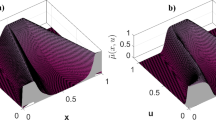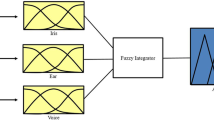Abstract
In this paper, we propose the use of Non-Singleton Interval Type-2 Fuzzy Systems (NSIT2FI) automatically designed through genetic algorithms as integration method of modular neural networks (MNN’s) for multimodal biometrics. The goal is to obtain such fuzzy systems as integrators, better recognition rate, and best mean square error in MNN. The results shown comparison between interval type-2 fuzzy systems and Non-singleton Type-2 Fuzzy Systems, where we can observe showing a significant difference that we can get higher recognition rate using non-singleton type-2 fuzzy logic.
Access this chapter
Tax calculation will be finalised at checkout
Purchases are for personal use only
Similar content being viewed by others
References
J.-S.R. Jang, C.-T. Sun, E. Mizutani, Neuro-Fuzzy and Soft Computing, A Computational Approach to Learning and Machine Intelligence, Prentice Hall, 1997.
J. Mendel, UNCERTAIN Rule-Based Fuzzy Logic Systems, Introduction and New Directions, Prentice Hall, 2001.
J. Mendel, Uncertain Rule-based Fuzzy Logic Systems, Prentice Hall, 2001.
Mendel, J., John, R., «Type-2 fuzzy sets made simple,» IEEE Transactions on Fuzzy Systems , nº 10, pp. 117-127, 2002.
Sahab, Nazanin and Hagras, Hani, «Adaptive Non-singleton Type-2 Fuzzy Logic Systems: A Way Forward for Handling Numerical Uncertainties in Real World Applications.» International Journal of Computers, Communications and Control , vol. 3, nº 5, pp. 503-529, 2011.
T. S. M. Takagi, «Fuzzy identification of systems and its application to modeling and control,» IEEE Transactions on Systems, Man, and Cybernetics, vol. 1, nº 15, 1985.
Qilian Liang, Jerry M. Mendel, «Interval Type-2 Fuzzy Logic Systems:,» IEEE TRANSACTIONS ON FUZZY SYSTEMS, vol. 8, nº 5, pp. 535-550, 2000.
Liang, Q., Mendel, J. , «Interval type-2 fuzzy logic systems: theory and design,» IEEE Transactions on Fuzzy Systems, vol. 5, nº 8, pp. 535-550, 2000.
Mendel, J., Mouzouris, George C., «Type-2 fuzzy logic systems,» IEEE Transactions on Fuzzy Systems, nº 7, pp. 643-658, 1999.
O. Castillo, P. Melin, Studies in Fuzziness and Soft Computing, Type-2 Fuzzy Logic: Theory and Applications, Tijuana , Baja California: Springer-Verlag Berlin Heidelberg, 2008.
Ricardo Martínez-Soto, Oscar Castillo, Juan R. Castro, «Genetic Algorithm Optimization for Type-2 Non-singleton Fuzzy Logic Controllers. : 3-18,» de Recent Advances on Hybrid Approaches for Designing Intelligent Systems, 2014, pp. 3-18.
Denisse Hidalgo, Patricia Melin, Oscar Castillo, «Type-1 and Type-2 Fuzzy Inference Systems as Integration Methods in Modular Neural Networks for Multimodal Biometry and its Optimization with Genetic Algorithms,» Journal of Automation, Mobil Robotics & Intelligent Systems, vol. 2, nº 1, pp. 53-73, 2008.
Juan R. Castro, Oscar Castillo, Luis G. Martínez, «Interval Type-2 Fuzzy Logic Toolbox.,» Engineering Letters, vol. 1, nº 15, pp. 89-98, 2007.
Karnik, N.N., Mendel, J., «Centroid of a type-2 fuzzy set,» Information Sciences, Vols. %1 de %2(1-4), nº 132, pp. 195-220, 2001.
Denisse Hidalgo, Oscar Castillo, Patricia Melin, «Type-1 and type-2 fuzzy inference systems as integration methods in modular neural networks for multimodal biometry and its optimization with genetic algorithms,» Information Sciences, vol. 179, nº Issue 13, p. 2123–2145, 13 June 2009.
Author information
Authors and Affiliations
Corresponding author
Editor information
Editors and Affiliations
Rights and permissions
Copyright information
© 2017 Springer International Publishing AG
About this chapter
Cite this chapter
Hidalgo, D., Melin, P., Castro, J.R. (2017). Non-singleton Interval Type-2 Fuzzy Systems as Integration Methods in Modular Neural Networks Used Genetic Algorithms to Design. In: Melin, P., Castillo, O., Kacprzyk, J. (eds) Nature-Inspired Design of Hybrid Intelligent Systems. Studies in Computational Intelligence, vol 667. Springer, Cham. https://doi.org/10.1007/978-3-319-47054-2_56
Download citation
DOI: https://doi.org/10.1007/978-3-319-47054-2_56
Published:
Publisher Name: Springer, Cham
Print ISBN: 978-3-319-47053-5
Online ISBN: 978-3-319-47054-2
eBook Packages: EngineeringEngineering (R0)




